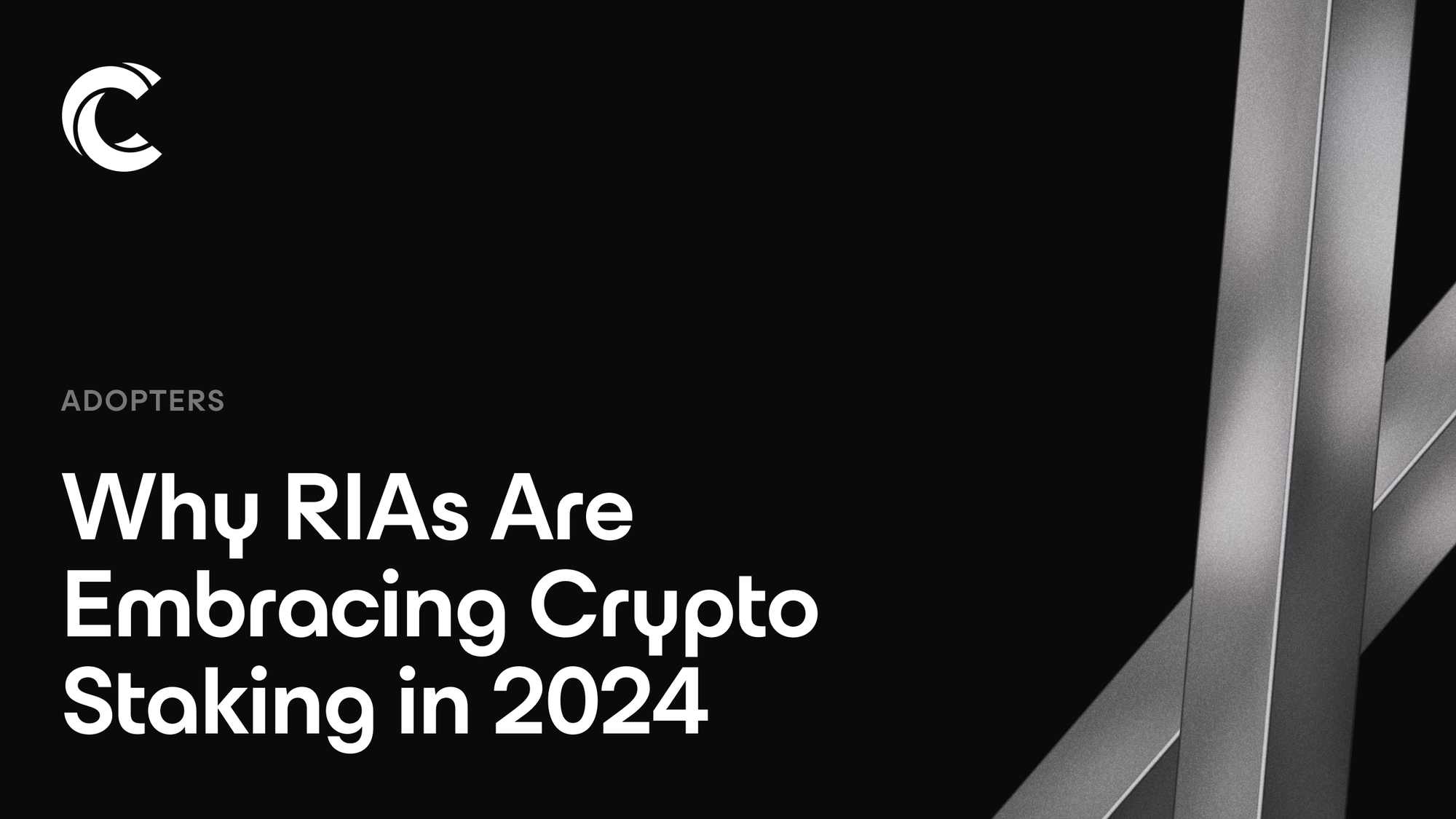Why RIAs Are Embracing Crypto Staking in 2024

According to a recent report by the SEC, more than 15,000 registered investment advisers (RIAs) in the U.S. were managing approximately $128 trillion in assets by the end of 2023, underscoring the expanding role of RIAs in modern financial services.
A growing number of these RIAs are exploring cryptocurrency investments as a way to diversify their clients’ portfolios. In fact, according to a DACFP & Franklin Templeton Digital Assets Advisor Pulse report, 59% of financial advisors polled in December 2023 said they were actively recommending crypto to their clients.
This interest has set the stage for RIAs to explore staking as an institutional product — the process of locking crypto in a protocol to help validate transactions in return for rewards that can be north of 10% APY.
However, staking requires a deep understanding of the mechanics, rewards structures, risks, tax implications, and regulatory responsibilities that come with it.
Let’s dive in.
Staking Strategies for RIAs
Building a diversified staking portfolio requires more than just choosing popular cryptocurrencies. RIAs need to consider client goals, the risk profile of each asset, and how these assets fit into an overall investment strategy.
Here are some key considerations for a solid staking strategy:
- Diversification of Staking Assets: Diversification helps mitigate the impact of potential protocol failures or market downturns by balancing high-yield assets with more stable ones. For instance, allocating across established projects like Ethereum and Solana, along with emerging assets like MINA, can create a balanced portfolio.
- Risk Management: Monitoring the health of a blockchain project is essential. Factors like governance, tokenomics, and network security can significantly impact staking outcomes. RIAs should actively review updates and potential risks within the protocols they stake.
- Liquidity: Staking can involve lock-up periods where assets are inaccessible, making liquidity a key factor. RIAs should assess the duration of lock-up periods and ensure they align with client liquidity needs so that funds are available when required.
- Reputable Service Providers: Choosing reputable, established staking providers helps minimize the risks associated with poor security or operational failures.
Regulatory Considerations for RIAs
With 52% of institutional investors surveyed in 2022 citing an uncertain regulatory environment as a primary concern for investing in crypto, the need for RIAs to carefully navigate crypto regulations remains crucial. While the SEC maintains scrutiny over digital assets, RIAs must understand that staking, in particular, carries its own unique regulatory considerations:
- Securities Law: Staking rewards may trigger securities law issues, particularly if the staking agreement meets the criteria for an “investment contract” under the Howey Test, as seen in recent SEC actions against Kraken and Coinbase. RIAs must be vigilant in assessing whether their staking offerings could fall into these categories.
- Custodial vs. Non-Custodial: Custodial staking involves third-party control of client assets, which brings additional oversight under custodial rules, whereas non-custodial staking leaves control with the client, impacting how assets are reported and safeguarded.
- Tax Implications: Staking rewards are generally considered taxable income upon receipt, as confirmed by IRS guidelines. RIAs should ensure that clients properly report staking income and stay updated on relevant tax laws to avoid unexpected liabilities.
- State Regulations: RIAs must consider specific laws governing crypto activities in their state. For instance, New York requires firms dealing with staking to obtain a license.
Compliance isn’t just about understanding the regulations — it’s about offering clear, transparent advice on the risks and rewards of staking, including information about liquidity constraints, lock-up periods, and potential price volatility. Clients expect their advisors to know the ins and outs of these assets while protecting their interests.
CoinList’s Staking Fund
As crypto becomes an increasingly mainstream asset, the potential for passive income and portfolio diversification is hard to ignore. Ready to dive into staking?
The CoinList Staking Fund currently supports MINA (13.84% APY), SOL (6.97% APY), NEAR (6.96% APY), ETH (3.76% APY), and SUI (3.35% APY), with more assets to come in the near future. We are able to add assets upon request from accredited investors, as long as the assets are PoS tokens that align with our service providers.
Legal Notice
This blog post is being distributed by Amalgamated Token Services Inc., dba “CoinList,” or one of its subsidiaries. This blog post and use of the CoinList website is subject to certain disclosures, restrictions and risks, available here.
Nothing herein should be construed as investment, legal or technical advice; consult your own advisors. CoinList and its employees, officers, directors, and affiliates may have interests in assets and/or projects featured in this blog post.
